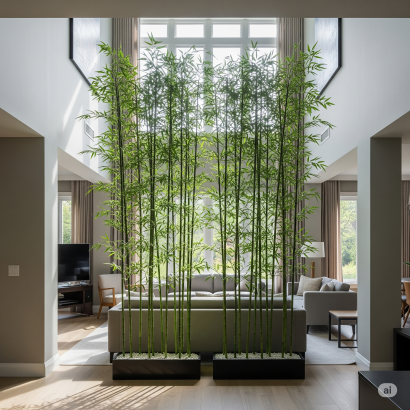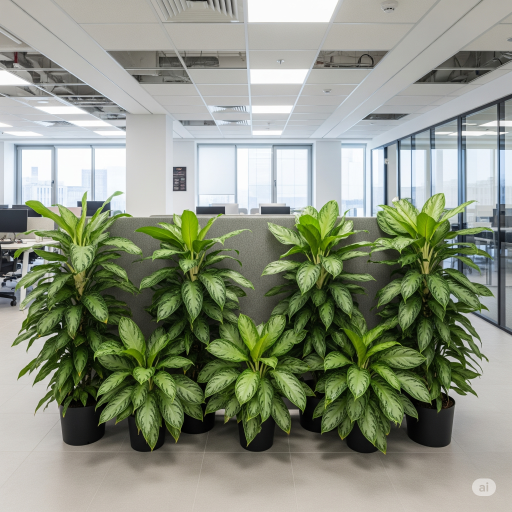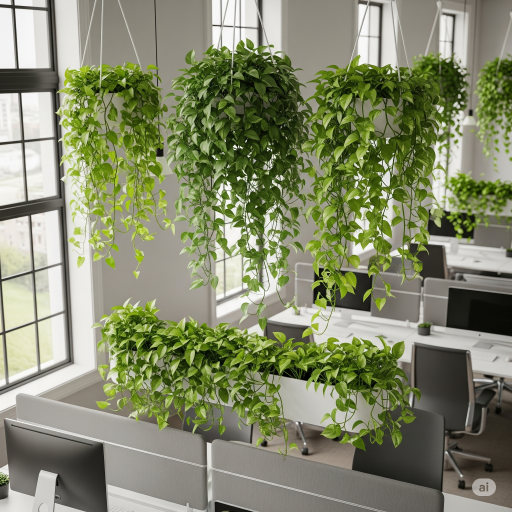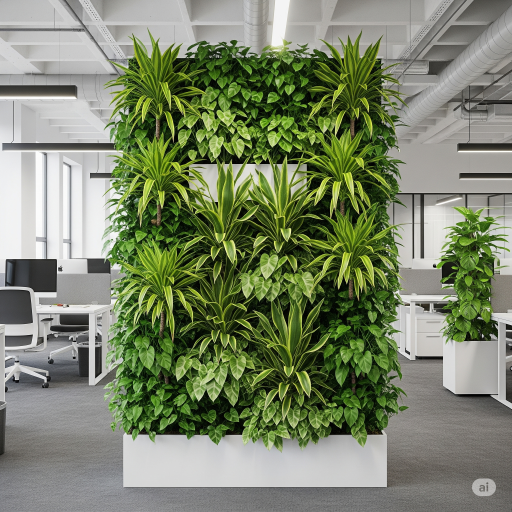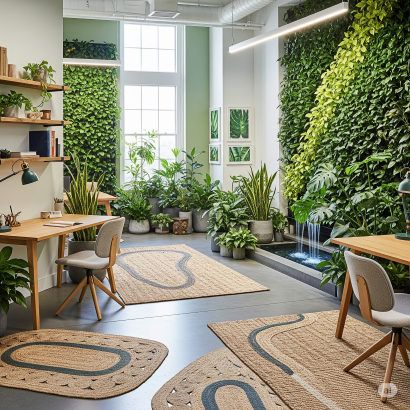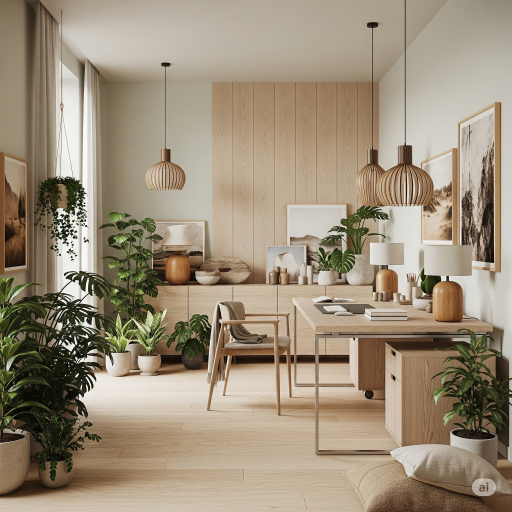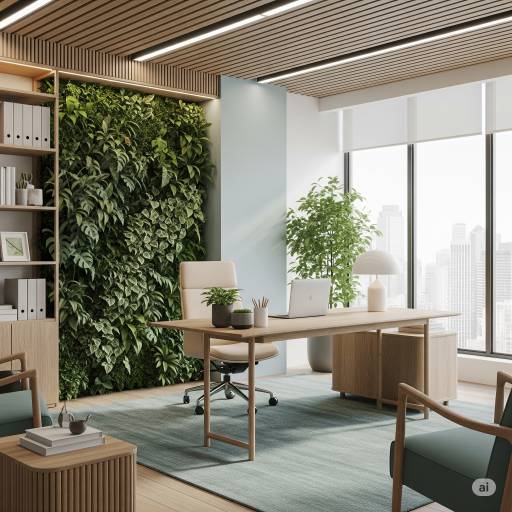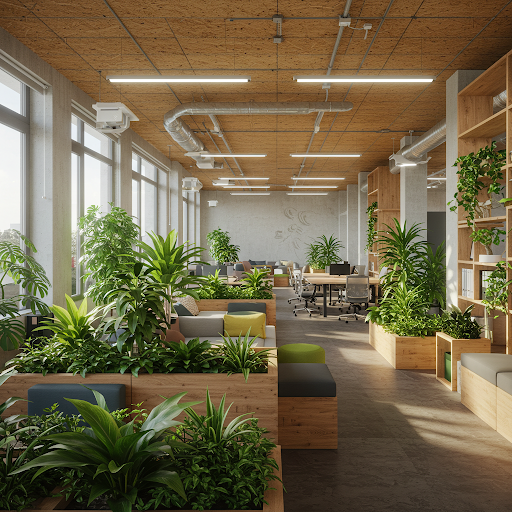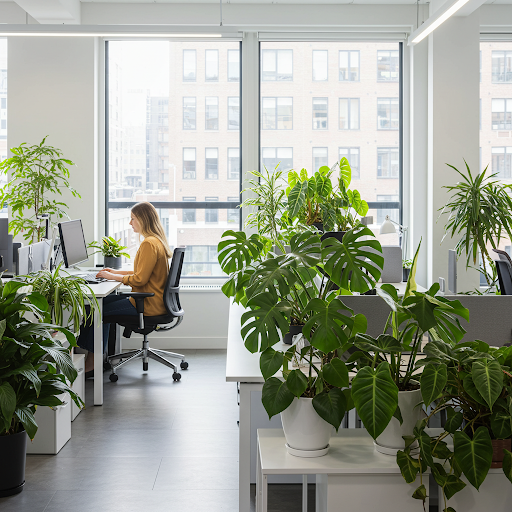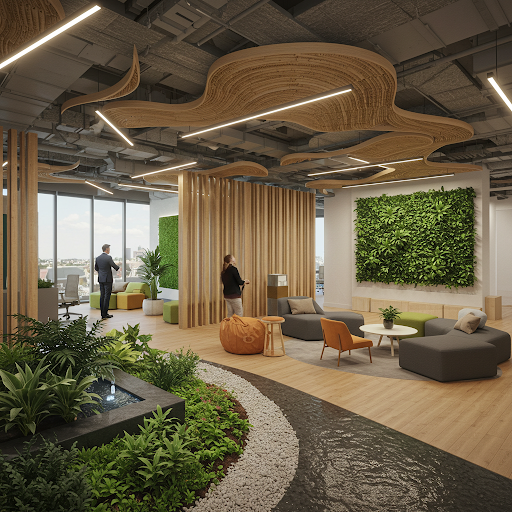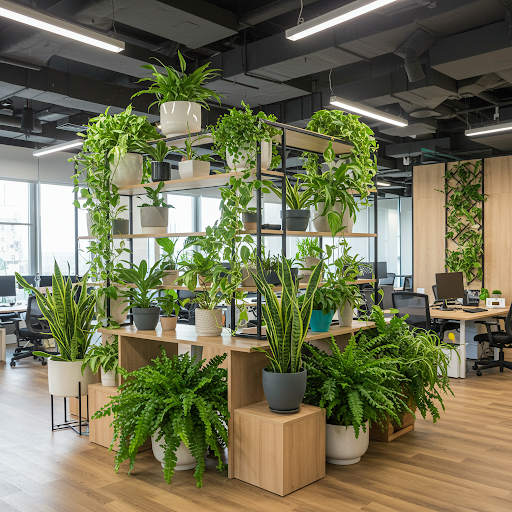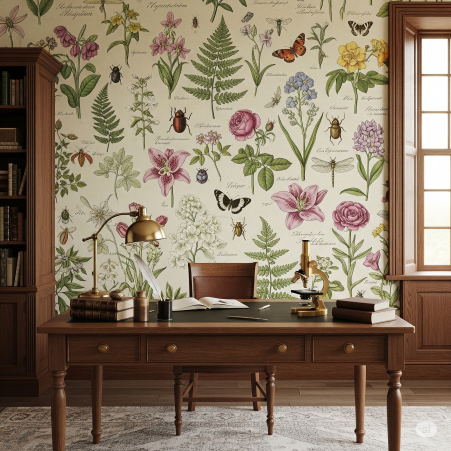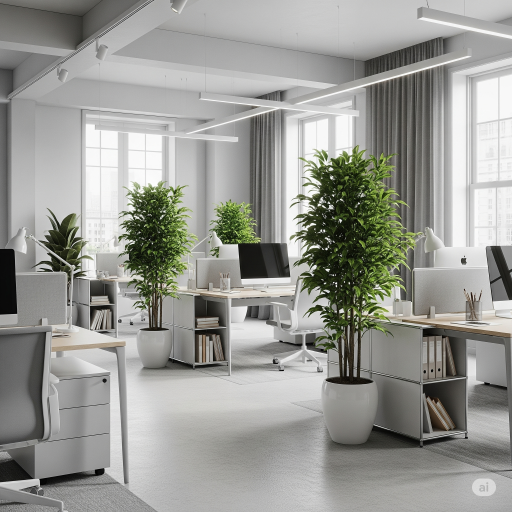Description
Office Reception Plants: The Biophilic Advantage
The reception area is the first impression a company makes on clients and visitors, and office reception plants are essential tools for creating a welcoming, professional, and visually appealing environment. The choice between a live plant and a high-quality faux version depends entirely on the office’s resources, light conditions, and aesthetic priorities.
Live plants offer unique health and wellness benefits that artificial alternatives cannot replicate, appealing to the innate human desire for connection with nature (Biophilia).
Key Benefits of Live Office Reception Office Plants
Air Purification
Living plants are active, natural air filters, utilizing their leaves and root systems to absorb harmful airborne toxins. They effectively neutralize common Volatile Organic Compounds (VOCs). Such as formaldehyde found in furniture and cleaning supplies, and benzene from synthetic materials. This biological process significantly contributes to better indoor air quality by detoxifying the environment. By continuously cleaning the air, the plants help to mitigate symptoms associated with “sick building syndrome,” ensuring that the reception area is not only visually welcoming but also physically healthier for both staff and visiting clients.
Mental Well-being
The innate human connection to nature, known as biophilia, means that the simple presence of live greenery in a reception area provides tangible psychological benefits. Numerous studies have demonstrated that viewing and interacting with plants effectively reduces physiological markers of stress, including lowering heart rate and blood pressure. For employees, this translates to improved overall mood, increased job satisfaction, and enhanced focus and concentration. By creating a calm, naturalistic environment, live plants help put clients at ease and foster a more relaxed and productive atmosphere for the staff who greet them.
Aesthetic Authenticity
Unlike their static, uniform artificial counterparts, live plants possess an unmatched aesthetic quality rooted in nature. Each plant exhibits natural variation, unique texture, and dynamic growth patterns that lend genuine vitality, warmth, and depth to a space. Over time, they subtly change—a new leaf unfurls, a flower blooms, or a stem reaches toward the light. This inherent responsiveness to the environment provides dynamic visual interest that continually engages the viewer, ensuring the reception area feels alive, authentic, and naturally inviting, making a more memorable and positive first impression.
Natural Humidification
In modern office buildings where air conditioning and heating systems often result in dry, stagnant air, live plants play a crucial role in regulating atmospheric comfort. They achieve this through transpiration, the natural process where water drawn up from the roots is released as water vapor through the pores in their leaves. This constant release of moisture into the surrounding air effectively increases local humidity levels. This natural humidification helps counteract the dryness of conditioned office environments, which can alleviate common discomforts like dry skin, irritated throats, and sinus issues for clients and employees alike.
Popular & Low-Maintenance Varieties of Office Reception Plants
Choosing the right live plants for an office reception area is crucial, as the space demands greenery that is both visually appealing and resilient enough to handle high-traffic environments, fluctuating temperatures, and, most importantly, occasional neglect. The following varieties are highly popular due to their low-maintenance requirements and impressive aesthetic impact:
1. Snake Plant (Sansevieria trifasciata)
The Snake Plant is a cornerstone of modern office decor. Its rigid, sword-like leaves grow vertically, offering a clean, architectural look perfect for minimalist or contemporary spaces. Its most significant advantage is its unparalleled resilience; it thrives on neglect, tolerates very low light conditions, and needs watering only once every few weeks, making it ideal for the busiest lobbies.
2. ZZ Plant (Zamioculcas zamiifolia)
The ZZ Plant is nearly indestructible, earning it the reputation of being the ultimate low-maintenance plant. It features waxy, deep green leaves that maintain a perpetually polished appearance. Since it stores water in rhizomes, it is extremely drought-tolerant and prefers to be ignored, happily tolerating both low light and inconsistent care schedules.
3. Pothos (Epipremnum aureum)
The Pothos is celebrated for its trailing vines and adaptability. Its heart-shaped, often variegated leaves cascade beautifully from shelves or tall planters, instantly softening hard architectural lines. It is exceptionally resilient and will tolerate a wide range of light levels, including bright offices and dim corners. It also clearly signals when it needs water by drooping slightly.
4. Peace Lily (Spathiphyllum)
The Peace Lily offers the benefit of both rich green foliage and elegant white flowers, bringing a touch of gentle sophistication. Crucially for an office, it’s a great low-light performer. Its dramatic wilting when thirsty serves as a clear, unmistakable indicator of its watering needs, making it easy to revive and keep looking fresh.
5. Cast Iron Plant (Aspidistra elatior)
As its name suggests, the Cast Iron Plant is incredibly tough, capable of surviving conditions that would kill most other houseplants. It features wide, deep green leaves and can tolerate deep shade, temperature extremes, and sparse watering. It’s a slow grower, maintaining a consistent, reliable shape for years, making it perfect for set placements.
6. Spider Plant (Chlorophytum comosum)
The Spider Plant is recognized for its arching, slender leaves and its tendency to produce “spiderettes” (small baby plants) on long stems. It’s highly adaptable, can handle a bit of neglect, and is an excellent air purifier. Its trailing nature makes it well-suited for hanging baskets or perching on tall reception counters.
7. Dracaena (various species)
Many varieties of Dracaena are excellent office choices. Species like Massangeana (Corn Plant) or Marginata (Dragon Tree) feature striking, colorful foliage on woody canes. They are generally tolerant of medium to low light and are easy to care for, requiring water only when the topsoil is dry.
8. Aglaonema (Chinese Evergreen)
The Aglaonema is prized for its beautiful leaf patterns, which come in combinations of red, pink, silver, and green. It is extremely popular because it thrives in low-light environments and prefers consistent, moderate watering, offering a vibrant splash of color without needing bright windows.
9. Succulents and Cacti
While not a single plant, a collection of large Succulents and Cacti (like large Aloes or Jade) makes stylish, nearly maintenance-free desk accents. They require bright light but thrive on minimal water, often just once a month, making them perfect for sunny reception windows or bright desks.
10. Rubber Plant (Ficus elastica)
The Rubber Plant is a statement piece with large, thick, glossy leaves that can be deep green or burgundy. While it appreciates bright, indirect light, it is much more tolerant of low light than the Fiddle Leaf Fig and requires infrequent watering, offering a dramatic, substantial look with manageable care.
Disadvantages of Live Reception Office Plants
Maintenance
Live plants demand ongoing and varied care, including regular watering tailored to each species, pruning to maintain shape, and occasional fertilization. Monitoring for pests is also essential. This complexity often necessitates hiring a dedicated, costly maintenance contract, increasing operating expenses.
Light Dependence
Live plant placement is restricted by natural light availability. Species will quickly die, wilt, or develop a sickly, pale appearance in windowless offices, dark hallways, or deep interior corners, severely limiting design flexibility and ideal placement options.
Allergies/Pests
Introducing live plants carries the risk of allergy and hygiene issues. They can produce pollen, causing discomfort for sensitive employees and clients. Furthermore, the soil and foliage can attract and harbor small insects, leading to potential pest outbreaks within the shared office environment.
Artificial Reception Office Plants: The Practical Solution
Modern, high-quality artificial (faux) plants are meticulously crafted to mimic the appearance of real foliage, offering a worry-free aesthetic solution.
Key Benefits
Zero Maintenance
Artificial plants demand absolutely no water, pruning, or specific light requirements. This eliminates the ongoing costs of a live plant maintenance schedule, including labor, fertilizer, and replacement costs due to plant failure, offering a truly hands-off aesthetic solution.
Versatility in Placement
Faux plants are not bound by biological needs. They can be successfully integrated into any location, including windowless offices, dimly lit hallways, or areas with extreme temperature fluctuations, allowing for complete freedom in design and placement.
Consistent Aesthetic
High-quality artificial foliage retains its vibrant color and perfect shape permanently. This consistency ensures the reception area always projects a flawless, polished, and professional image to clients, regardless of the season or lighting conditions within the building.
Allergy & Hygiene Friendly
Faux plants offer a sanitary solution by eliminating the risk of pollen or mold production, making them safe for clients and staff with allergies. Furthermore, they do not attract soil-based pests, ensuring a clean and hygienic environment.
Longevity
Investing in high-quality artificial plants is a cost-effective choice. Their durable construction means they rarely need replacing. That transforms the initial purchase into a durable, long-term asset that maintains its premium appearance for many years.
Popular & Realistic Varieties of Artificial Office Reception Plants
When selecting artificial (faux) plants for a professional reception area, the focus shifts entirely to realism, durability, and visual impact. Modern manufacturing techniques create highly convincing replicas that deliver stunning aesthetics without any maintenance concerns. The following varieties are popular for their ability to convincingly mimic their live counterparts and make a bold statement:
1. Faux Fiddle Leaf Fig (Ficus lyrata)
The Fiddle Leaf Fig has become an icon of contemporary, luxurious design, making its artificial counterpart extremely popular in high-end office lobbies.
Key Features
It is defined by its large, broad, violin-shaped leaves and tall, structured trunk. A good faux version mimics the subtle vein texture and slight irregularities of the leaves for maximum authenticity.
Aesthetic Impact
It provides an instant, modern, and sculptural focal point that conveys sophistication. Because the real plant is notoriously difficult to keep healthy, the faux version ensures this demanding aesthetic is always perfectly maintained.
Best Placement
Ideal as a large floor accent in open corners, next to comfortable seating, or near elevators where it receives heavy client scrutiny.
2. Faux Monstera (Split-Leaf Philodendron)
The Monstera is known for its distinctive, large, perforated leaves, which immediately introduce a lush, tropical, and modern flair.
Key Features
Look for versions with large, deep green leaves that feature the characteristic natural “splits” or holes (fenestrations). The material should have a slightly waxy, lifelike texture.
Aesthetic Impact
Its large foliage is excellent for softening hard architectural lines and adding a sense of organic vitality to large, sterile lobby spaces. It communicates a design-forward, welcoming atmosphere.
Best Placement
Effective in spacious lobbies, reception areas with high ceilings, or in groupings near break-out spaces to create an urban jungle feel.
3. Faux Bamboo Tree
The artificial Bamboo Tree is valued for its unique ability to screen, divide, and add height with a light, airy appearance.
Key Features
It features slender, jointed stalks and dense, airy clusters of small, delicate leaves. High-quality versions use realistic materials for the canes.
Aesthetic Impact
It is used effectively to visually divide large open-plan reception areas or to provide a gentle, natural privacy screen without blocking all light. It adds a peaceful, Eastern-inspired element.
Best Placement
Perfect for transitional zones, along low walls, or behind reception seating to provide subtle vertical interest and partitioning.
4. Faux Succulent and Terrarium Arrangements
These small, intricate arrangements are perfect for adding sophistication and intricate detail directly on furniture surfaces.
Key Features
They consist of small, highly structured plants like Echeveria, Sempervivum, and Haworthia. The faux versions are almost indistinguishable from real succulents due to their compact size and often rubbery texture.
Aesthetic Impact
They convey a clean, contemporary, and organized aesthetic. Arranged in glass bowls or minimalist pots, they add a subtle touch of natural texture without taking up much space.
Best Placement
Ideal for the main reception counter, coffee tables, or small shelving units where clients wait and appreciate close-up detail.
Large Statement Floor Plants
Faux Olive Tree
Offers a Mediterranean, airy, and sophisticated look with silvery-green leaves. Faux Olive Tree is trendy in minimalist and neutral-toned reception areas.
Faux Dracaena (Dragon Tree/Mass Cane)
Replicates the real Dracaena plant’s colorful, tufted foliage and strong, woody canes, adding a bold, vertical line and tropical color.
Mid-Sized & Vertical Accents Indoor Office Plants
Faux Snake Plant (Sansevieria)
Chosen for its architectural, upright, sword-like leaves. Faux Snake Plant’s verticality is perfect for modern decor and narrow spaces.
Faux Yucca
Artificial Yucca features spiky, rosette-forming leaves on a single trunk, lending a Southwestern or desert modern aesthetic that looks very structural and clean.
Faux Bird of Paradise
Distinctive for its large, paddle-shaped leaves, bringing a dramatic, tropical, and sculptural element to the room.
Faux Rubber Plant (Ficus elastica)
Artificial Rubber Plant’s large, thick, glossy leaves (often in deep burgundy or green) create a substantial, luxurious, and bold visual statement.
Desk, Countertop, and Trailing Office Plants
Faux Pothos Trailing Vine
Artificial Pothos used to trail realistically from high cabinets, shelves, or the edges of reception desks, softening hard edges and adding a cascade of green.
Faux Orchid Arrangement
Artificial Orchid arrangement offers elegant, high-impact white or colored blooms that signify luxury and attention to detail, ideal for the main reception desk or executive areas.
Faux Ferns (e.g., Boston Fern)
Artificial Ferns Office Plant provides a classic, bushy, and lush texture, often used in hanging baskets or in darker corners where a live fern would quickly perish.
Faux Calathea (Prayer Plant)
Artificial Calathea Office Plant is valued for its unique, colorful leaf patterns (stripes, spots), adding intricate visual interest and a sophisticated touch to smaller surfaces.
Faux Air Plants (Tillandsia)
Artificial Air Plants used in contemporary glass terrariums or mounted on wood, these tiny, unique plants require zero care and add a clean, artistic, and modern decorative touch.
Disadvantages
Also known as imitation plants, artificial plants have gained popularity in recent years as a convenient and attractive option for office decor. However, they also come with some drawbacks that are worth considering.
No Health Benefits
They do not purify the air, improve well-being through biophilia, or contribute to air humidification.
Initial Cost
High-quality, realistic faux plants can have a significant initial cost compared to small live plants.
Dust Accumulation
They require regular dusting to maintain a realistic and professional appearance.
Conclusion: The Deciding Factor for Reception Office Plants
The ultimate choice depends on your specific reception environment:
| Choice | Ideal Environment |
| Live Plants | High natural light, dedicated maintenance staff, and a priority on employee well-being and sustainability. |
| Artificial Plants | Low or no natural light, high-traffic areas where durability is key, or a desire for a consistent, maintenance-free, polished aesthetic. |


